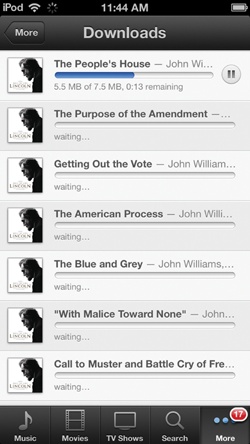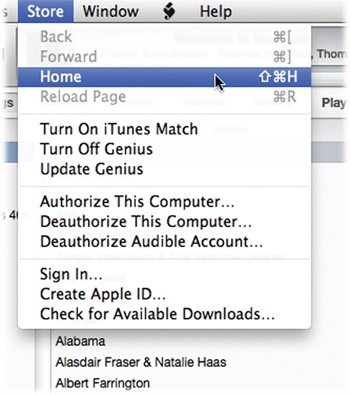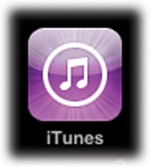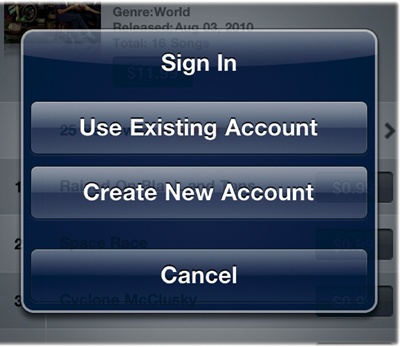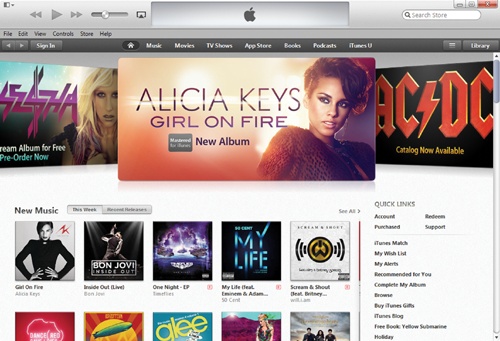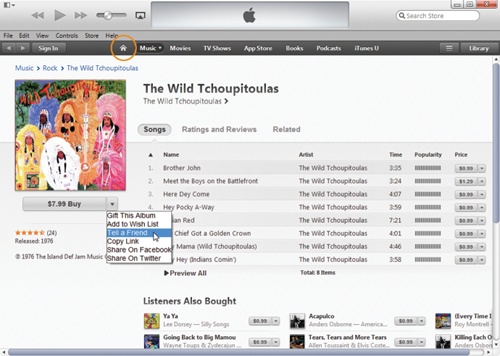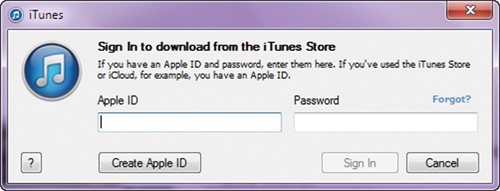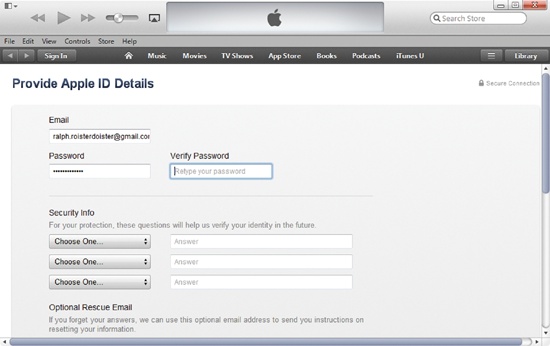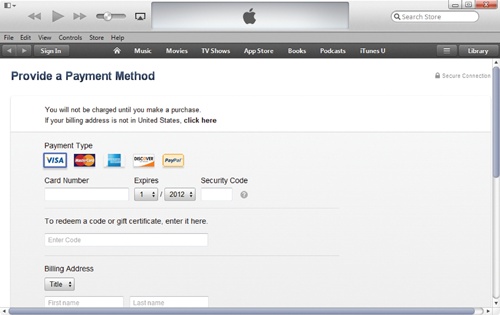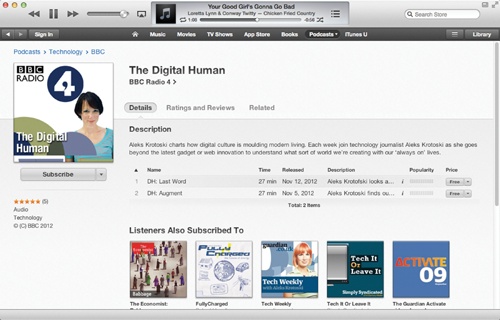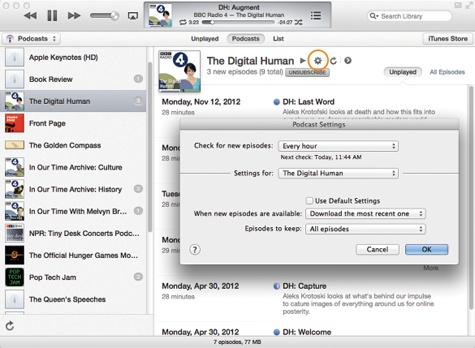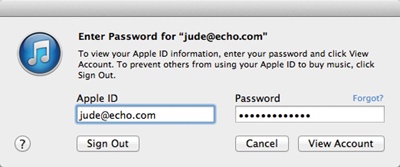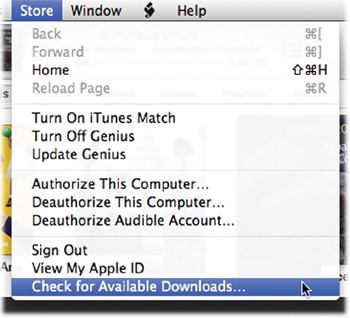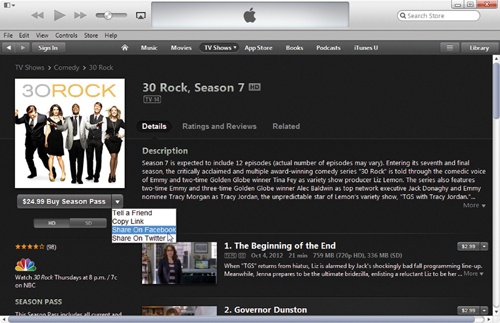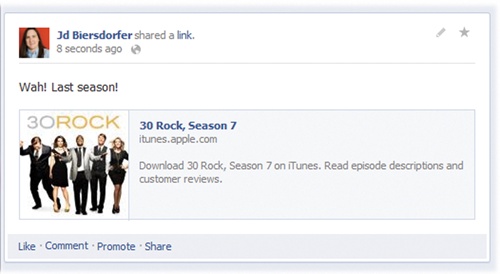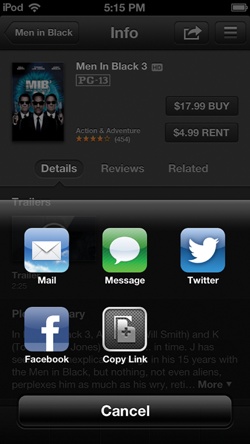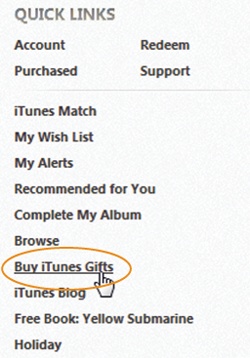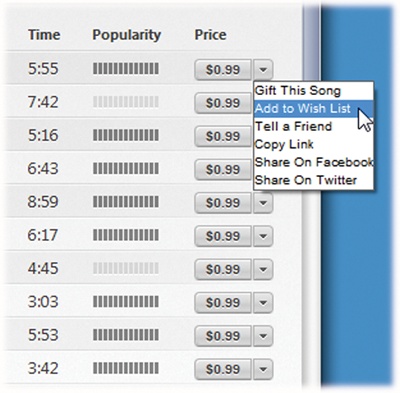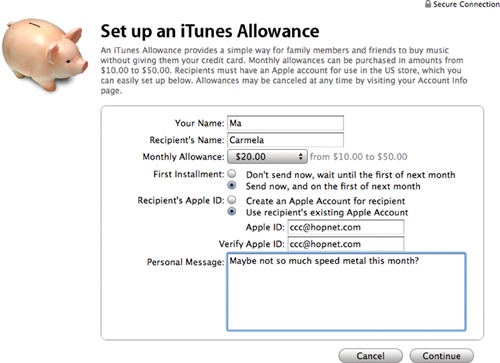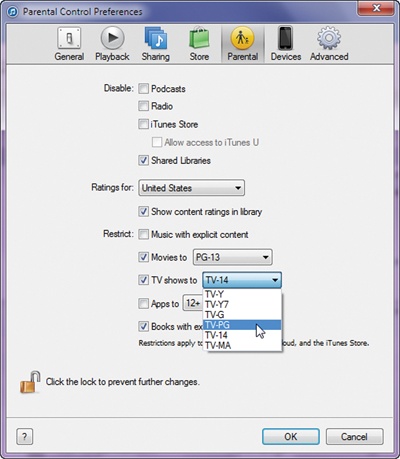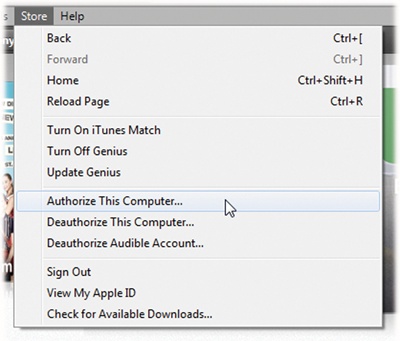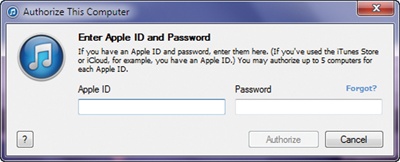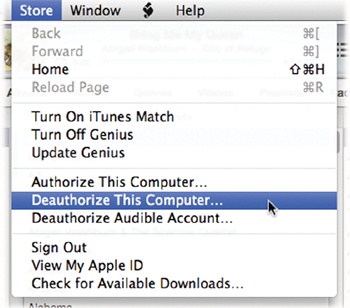Chapter 13. Shop the iTunes Store
You’ll learn to:
Navigate the iTunes store
Buy and download music, videos, books, and more
Set up an Apple account
Subscribe to podcasts
Share your tastes on Facebook and Twitter
Give iTunes gifts
MUSIC FANS HAVE BEEN downloading songs from the Internet since the 1990s, from sites that were legal and others that were, well, not so much. People loved the convenience, but record companies saw potential profits slipping down millions of modem lines. They fought back by suing file-sharing services and other software companies for aiding and abetting copyright infringement.
The need for a legal music-download site was obvious, but most early efforts resulted in skimpy song catalogs and confusing usage rights. Things changed dramatically in April 2003, when Apple opened its online iTunes Music Store, selling legal, iPod-ready digital versions of popular songs for 99 cents a pop. In January 2009, Apple did away with the restrictive copy protections built into most Store songs. This liberating act gave consumers unfettered use of their songs and even the ability to play them on (gasp!) non-Apple players.
Now simply called the iTunes Store, the media emporium’s virtual shelves stock millions of songs, plus full-length movies, TV shows, iPod Touch programs, audio books, ebooks, podcasts, music videos, and more. It’s all custom-tailored for the iPod, and best of all, once you buy a title, it’s yours to keep (rentals, of course, come with a time limit). This chapter shows you how to find and use the media you’re looking for, and how to get the most out of the iTunes Store.
Get to the iTunes Store
COMPARED WITH BUYING GAS, fighting traffic, and finding a parking spot at the mall, getting to the iTunes Store is easy. All you need is an Internet connection and a copy of iTunes running on your computer. Then you can either:
Click the iTunes Store button (circled) in the top-right corner of the iTunes window. You land squarely on the Store’s home page, where you can start clicking on what looks good.
If you like to get places by way of menus or keyboard shortcuts, iTunes lets you live the dream. In Windows, press Crtl+B to show the iTunes menu bar (if it’s not visible already) and choose Store→Home. The keyboard shortcut is Ctrl+Shift+H. On the Mac version of iTunes, choose Store→Home, or press ⌘-Shift-H on the keyboard.
Once you land in the iTunes Store, you can preview suggested songs by clicking the ![]() icon that appears in front of a track’s title when you pass your cursor over the song. The Buy button is always nearby waiting for your impulse purchase, making it extremely easy to run up your credit card tab.
icon that appears in front of a track’s title when you pass your cursor over the song. The Buy button is always nearby waiting for your impulse purchase, making it extremely easy to run up your credit card tab.
If you have an iPod Touch and are in range of a wireless network, you can get to the Store a third way: over the airwaves, as explained on the next page.
Tip
Longtime iTunes Store customers—especially those still stuck on dial-up modems—may be deeply dismayed to see the loss of the Shopping Cart feature from earlier versions of iTunes. The Shopping Cart, which let you pile up songs and then download them all at the end of your shopping session, has been loosely replaced with the Wish List feature, described on Plan Ahead: Wish Lists.
Shop the iTunes Store via WiFi
OWNERS OF THE IPOD Touch don’t even need a computer to shop the iTunes Store—those lucky souls can tap their way right into the Store over a wireless Internet connection. Many WiFi-enabled Starbucks coffee shops also let you hook into the iTunes Store for free to browse and buy music, including whatever track is playing at Starbucks.
To buy stuff when you’re out and about—and in the mood to shop:
Tap the purple iTunes icon on the Touch’s Home screen. Make sure you have a WiFi connection; see Chapter 5 for guidance on making that happen.
The Store appears on-screen. Tap your way through categories like “New Albums” until you find an album or song that interests you. (Tap an album to see all its songs.)
Tap a song title for a 90-second preview.
Tap the Music, Videos, or Search buttons at the bottom of the window for targeted shopping, or type in search terms from the Touch keyboard.
To buy and download music or videos, tap the price button, and then tap Buy.
Type in your Apple ID and let the download begin. You can check the status of your purchase-in-progress by tapping the Touch’s Downloads button, which also lets you pause a download if you need to. If you don’t have an Apple ID (which Apple sometimes colloquially refers to as “an iTunes Store account”), tap the Create New Account button on the Sign In screen and follow the steps. You sign in and out of your account with a link at the bottom of the media listings. Tap the Purchased icon to see all the things you’ve ever bought from iTunes on any computer or iOS device—and download them again here.
When iTunes finishes downloading your purchases, you have some brand-new media ready to play on your Touch—the new acquisitions land on your media app’s Purchased page. To get those freshly harvested songs or videos back into the iTunes library on your computer, sync up the Touch. The tracks pop up in the iTunes playlist creatively titled “Purchased.”
The iTunes Store Layout
THE ITUNES STORE IS jam-packed with digital merchandise, all neatly filed by category in links across the top of the main window: Music, Movies, TV Shows, and so on. The clean design of iTunes 11 makes the Store even more browse-worthy than before. Click a link to go to a Store “aisle.” You can also hover your mouse over a link and click the triangle that appears; a pop-up menu lets you jump to a subcategory within that category (Blues or Pop in Music, for example).
The main part of the iTunes Store window—that big piece of real estate smack in the center of your browser—highlights iTunes’ latest audio and video releases and specials. It’s usually stuffed full of digital goodies, so scroll down the page to see featured movies, TV shows, and apps. Free song downloads and other offers appear down below, too.
To find a specific item, use the search box in the upper-right corner; enter titles, artist names, and other searchable info.
The Quick Links box on the right side of the window has shortcuts to iTunes gift certificates (see Give the Gift of iTunes), iTunes Match (Use iTunes Match), Genius suggestions, an advanced search feature, your account settings, tech support, and more.
As you scroll, you also see Top Ten lists along the right side of the screen, showing you the hottest-selling items in the Store at that very moment.
Navigate the Aisles of the iTunes Store
YOU NAVIGATE THE ITUNES Store just as you navigate a website—by using links on the Store’s page. Most artist and album names, for example, are links—click on a performer’s name or an album cover to see a list of associated tracks.
Click the button with the small house on it (circled below) to jump to the Store’s home page, or click iTunes’ Back button in the upper-left corner (to the far left of the house) to return to a previous page.
When you find the name of an album or performer you’re interested in, click it to jump to a detail page. You’ll see a list of all the tracks on an album. Click the Ratings and Reviews button to see opinions from other iTunes users. Click Related to see a list of similar albums you can buy. Double-click a track title to hear a 90-second snippet. If you’re shopping for videos or audiobooks, you can preview them, too.
If you get excited by something you find and want to share it with friends—or want to drop a not-so-subtle hint for birthday gifts—click the black triangle next to any Buy button to get a pop-up menu that lets you email a link to the item to a pal or post your discovery on your Facebook or Twitter page.
Set Up an Apple Account
BEFORE YOU CAN BUY any of the cool stuff in the iTunes Store, you need to set up an account with Apple, also known as an Apple ID. To do so, click the Sign In button on the upper-right corner of the iTunes window. In iTunes 11, you can also choose Store→Create Apple ID from the main menu bar.
If you’ve ever bought or registered an Apple product on the company’s website, signed up for an AppleCare tech-support plan (AppleCare—What It Is and Whether You Need It), ordered prints, books, or calendars from iPhoto, or used another Apple service, you probably already have the requisite Apple login info. All you have to do is remember your Apple ID (usually your email address) and password.
If you’ve never had an Apple ID, click Create Apple ID. That launches the iTunes Store Welcome screen, where you follow three steps:
As your first step in creating an Apple ID, you must read and agree to the long, scrolling legal agreement on the first screen. The multipage statement informs you of your rights and responsibilities as an iTunes Store and App Store customer. It boils down to this: Thou shalt not download an album, burn it to CD, and then sell bootleg copies of it at your local convenience store and Third-party crashware apps are not our fault.
Click the Agree button to move on to step 2. Here you create an Apple user name, password, and secret questions and answers. If you later have to click the “Forgot Password?” button in the Store sign-in box, this is the question you’ll have to answer to prove that you’re you. Apple also requests that you type in your birthday to help verify your identity—and to make sure you’re old enough to use the service (iTunes account holders have to be 13 or older).
On the third and final screen, tell Apple how you want to pay for purchases: provide a valid credit card number and a billing address, or type in your PayPal account info.
Click Done. You’ve got yourself an Apple ID. From now on, you can log into the iTunes Store by clicking the Sign In button in the upper-left corner of the Store’s horizontal toolbar.
Browse and Buy Media From the Store
Over the past decade, the iTunes Store has grown from a rare source of legal music-files downloads with just 200,000 tracks to a sprawling mall of 26 million songs. And that’s just music: The iTunes Store also has 45,000 movies, 190,000 TV episodes, 700,000 apps, and all kinds of other digital goodies like podcasts, ebooks, and free educational content from iTunes U.
So, you’ve got your Apple ID and you’ve just clicked the iTunes Store button on the iTunes 11 toolbar. Now what? Basically, you browse, you buy, and you download.
For many people, the browsing is the fun part—clicking around through the different categories of digital merchandise, listening to samples, watching previews, and getting acquainted with the stuff in the Store. The row of buttons across the top of the window take you to each type of content.
You can jump into shopping here two ways. The first is to click the button for the kind of media you want—Movies, TV Shows, and so on. To browse songs and albums, for example, click the Music button. You’ll see all the styles of music the Store has to offer. To narrow your choices, click the All Categories drop-down menu on the right side of the page. It, too, lists the genres of music the Store carries; click one to see the selection.
If you know what kind of media you want right off the bat—say a little Latin pop to pep you up—use the second option: jump to subcategories for each type of content by sliding your cursor over the category name and clicking the arrow that appears next to the name. For example, clicking the arrow next to Music gives you a world of music styles to choose from (below).
Speaking of media categories, here’s what you’ll find in the iTunes Store just by clicking the buttons lined up in a row at the top of the window:
Music. Millions of tracks await you here, all as high-quality 256 kilobits-per-second AAC files that play on iPods, iPhones, Apple TVs, and even hardware Apple doesn’t sell. Prices for single tracks start at 69 cents, move up to 99 cents, and generally top out at $1.29. Entire albums can cost anywhere from about $8 to $15, but many come with digital versions of the old-school CD booklet. You also get album artwork on each track, which makes your collection look amazing in the new Album view of iTunes 11 (Chapter 10).
Movies. Hollywood has an aisle in iTunes, with the latest home video releases arriving in the Store every week. You often have a choice of picture quality: standard definition or high-definition, depending on what your device can handle. If you don’t want to buy, you can often rent a film to watch within 24 hours—but you have 30 days to start that 24-hour period. Some movies include iTunes Extras, DVD-like bonus features you can watch on your Windows PC or Mac. Movie rentals start at $2 for a standard-def short, and the latest HD release with all the Extras will run you about $20.
TV Shows. Like movies, you can buy many TV show episodes in standard definition or high-definition format, for a respective $2 or $3 a pop. Since TV shows tend to come out regularly, you can buy a Season Pass (usually $25 and up) or a Multi-Pass (typically about $10 for the next 15 installments of a half-hour daily talk show or similar program) and have iTunes download them automatically, as you’ll see later in this chapter.
App Store. iPod Touch owners can browse away for new games and programs to run on their devices here from the comfort of the big iTunes window. Some apps are free, lightweight bits of code, but there’s nothing “mini” about many Touch programs these days—a 250-megabyte word-processing program for $10 and $7 games with fancy graphics that take up more than a gigabyte of Touch-space are among the thousands of offerings.
Books. No matter whether you like to read books yourself or have them read to you, you’ll find ebooks that work with the Touch’s iBooks app here, as well as audiobooks that work on all iPods. Prices start at free and go up to about $15 for a current best seller in ebook form, or $30 in audiobook form. The Books department of the Store sells textbooks, children’s books, books in Spanish, and digital comics as well.
Podcasts. Like those free audio and video shows? Click the Podcasts button to find them (and turn the page to read more about them).
iTunes U. Apple’s free-and-massive collection of educational materials from major universities can be found here, ready for you download and absorb.
Download and Subscribe to Podcasts
PODCASTS ARE ONE OF the iTunes Store’s hidden gems. You’ll find thousands upon thousands of these free audio (and video!) programs put out by everyone from big television networks to a guy in his basement with a microphone.
To see what podcasts are available, click the Podcasts link at the top of the Store’s main page. You’ll see three buttons atop the page that opens: All, Audio, and Video. Click one of the latter two to jump to just audio or video podcasts, or click the triangle beside the Podcasts button for a list of podcast topics. On the main Podcasts page, you can browse shows by category, search for podcast names by keyword (use the Store’s search box), or click around until you find something that sounds good.
Many podcasters produce regular installments of their shows, releasing new episodes as they’re ready. You can have iTunes keep a lookout for fresh editions and automatically download them; all you have to do is subscribe to the podcast. Click the podcast you want, and then click the Subscribe Now button underneath the artwork. If you want to try out a single podcast, click the Free link near its title to download just that one show.
Although podcasts have a reputation as home-brewed projects—and there are many of those in the Store—you can also find hundreds of professional productions. Missed your favorite nightly network newscast? Check iTunes, where you might be able to grab it for free (NBC and PBS are among the companies that make many of their shows available as complimentary video downloads for a short time after the initial broadcast.) You can find many BBC and NPR radio shows available as podcasts as well, which lets you time-shift your listening.
Once you subscribe to a podcast, you can manage your episodes back in your iTunes library. Click on the Library drop-down menu in the top-left corner and choose Podcasts. The page displays all the shows you subscribe to and includes the number of episodes (both played and unplayed) waiting for you in iTunes.
As shown above, you can tell iTunes to automatically check for new episodes of each subscribed podcast more or less often (every hour to every week). Click the Settings icon (circled) on the library’s Podcasts screen to set your options.
Tired of a podcast and want to stop the downloads? Select Podcasts from the Library’s drop-down menu in the top-left corner of the iTunes window. Select the show in the list and then click the Unsubscribe button at the top of the window. To remove a podcast and all its episodes, click a title and hit the keyboard’s Delete button.
Tip
Podcasts, music, movies, books—there are so many things in the iTunes Store to look at, it’s hard to remember it all. If you can’t quite recall where you saw that cool thing you wanted to buy but didn’t at the time, you can kickstart your memory with the History button (![]() ). Click it in the iTunes Store window to see a list of items you recently browsed. You need to be logged into your Apple ID to see the browsing trail, but it does provide a quick trip down memory lane.
). Click it in the iTunes Store window to see a list of items you recently browsed. You need to be logged into your Apple ID to see the browsing trail, but it does provide a quick trip down memory lane.
Change the Information in Your Apple ID Account
YOU CAN CHANGE YOUR billing address, switch the credit card you have on file, and edit other information in your Apple account without calling Apple. Just launch iTunes and choose Store→View My Apple ID. In the box that appears (shown below) enter your Apple user name and password and click the View Account button. (If you’re already signed in and shopping around when you want to change your account information, go to the left side of Store’s toolbar and click the button that has your Apple user name on it to get to the box shown here.)
You land on your Account Information page. To change your billing address or payment information, click Edit next to the item you want to change. You can also deauthorize all the computers that can play songs purchased with this account (more on why and when you’d want to do that on Deauthorize Your Computer).
You can change other account settings here, too, like the nickname that appears when you post a customer review in the Store. You can also see how many of your iOS devices and computers you have looped into the automatic downloads feature of iTunes in the Cloud (Use iTunes In the Cloud), review your Purchase History (a list of everything you’ve ever bought from the iTunes Store, as you’ll find out later in this chapter), and control the alerts the iTunes Store sends you when it thinks you should spend more money inside its electronic walls.
When you finish making your changes, click Done at the bottom of the screen.
Resuming Interrupted Store Downloads
IT’S BOUND TO HAPPEN sometime: You’re breathlessly downloading a hot new album or movie from iTunes, and your computer freezes or your Internet connection goes on the fritz. Or you and your iPod Touch were in the middle of snagging an album when the rest of the gang decided it was time to leave the coffee shop.
If that happens, don’t worry. Even if your computer crashes or you get knocked offline while you’re downloading purchases, iTunes is designed to pick up where it left off. Just restart the program and reconnect to the Internet.
If, for some reason, iTunes doesn’t go back to whatever it was downloading, choose Store→Check for Available Downloads to resume the download.
You can use this same command to check for available purchases any time you think you might have something waiting, like a new episode from a TV show Season Pass. You’ll also find any digital booklets that come with albums you bought here—those don’t download to your Touch from the WiFi Store because they’re PDF files meant to be viewed on your computer.
Tip
If you need help from a human at Apple, you can either call them at (800) 275-2273 or drop them an email. To email them, click the Support link on the iTunes Store’s main page. You’ll see the main iTunes service and support page; click any link in the Customer Service area and then, at the bottom of the page that appears, fill out the Email Support form. Live online chat is also available for some issues.
iTunes and Social Media
IF YOU SPEND ANY amount of time online these days, there’s no escaping Facebook and Twitter as sources of breaking news, information, and sharing. Social media is here to stay.
Ping, Apple’s two-year attempt at a music-themed social network, regally cannonballed into the Pool of Public Indifference and shut down in September 2012. But even in the absence of Ping, you can use the power of Facebook and Twitter to share your taste in music, movies, books, apps, and podcasts with your friends and followers—right from the iTunes Store.
On just about any product page in the Store, the Buy button offers a menu (shown below) with four ways to share your idea of a cool purchase: Tell a Friend (by email), Copy Link (for pasting into a blog or other online page), Share on Facebook, and Share on Twitter. Once you make your selection, iTunes creates a link to the item; your recipients and readers see your endorsement and can click on the link to go right to that item in the Store.
Yes, using these links gives Apple free publicity by having you flog its wares. But sharing links from the Store can also help promote a small indie band, a new podcast, or a TV show you think your friends should be watching—so you can all talk about it online.
You can also tout your taste in Music on the iPod Touch versions of Apple’s iStores. In the top-left corner of any product page, tap the ![]() icon to open up a menu of sharing options: Mail, Messages, Twitter, Facebook, or the good old Copy option.
icon to open up a menu of sharing options: Mail, Messages, Twitter, Facebook, or the good old Copy option.
To use the Facebook and Twitter options, you need to have your accounts linked to the iPod’s Facebook or Twitter apps (Chapter 4) in iOS 6; Messages is also covered there. If you haven’t set up Mail yet, take a stroll through Chapter 5.
Get iTunes News on Twitter
Apple maintains a number of official Twitter feeds. To keep up with the latest news from iTunes World, follow these self-explanatory accounts:
To follow any Twitter account, open the Touch’s Twitter app (Add Twitter and Facebook Accounts), tap the ![]() icon, and then type in the name of the account. On the search results screen, tap the People tab at the top of the window, find the account (say, @iTunesU) in the list, and then tap Follow to add the account to your Twitter feed.
icon, and then type in the name of the account. On the search results screen, tap the People tab at the top of the window, find the account (say, @iTunesU) in the list, and then tap Follow to add the account to your Twitter feed.
Give the Gift of iTunes
IF YOU’RE STUMPED TRYING to find something for The Person Who Has Everything, consider a gift of iTunes Store credit or music. Apple conveniently gives you several ways to send the gift that keeps on giving—or at least the gift that keeps on rocking out.
Gift certificates. To buy an iTunes gift certificate, click Buy iTunes Gifts in the Quick Links box on the Store’s main page, and then select a gift denomination ($10 to $50). You can email the certificate to the recipient, or you can print it out and deliver it yourself. The rest of the process is like buying anything else on the Web: fill in your address, add a message, and so on. You need an Apple ID to send and use gift certificates.
To redeem an electronic gift certificate, go to the iTunes Store and click the Redeem link in the main window. Copy the Redeem Code from your email and paste it into the box provided. (If you got a printed certificate, type in the gift code.) Click Redeem, and then start shopping.
Gift cards. The brightly colored prepaid iTunes Music Card is a fun spin on the gift certificate concept. Available in dollar amounts from $15 to $100, givers can find cards at places like Amazon.com, Target, and Apple’s own stores. You can also buy them in the iTunes Store (and have them mailed out by the Postal Service) by clicking the Buy iTunes Gifts link. Recipients can spend it all in one place—the iTunes Store—by clicking the Redeem link on the Store’s main page.
Gift content. In a daring feat of bending a noun into a verb, the iTunes Store also lets you “gift” selections of music, videos, or apps. Your recipient can download your thoughtful picks right from the Store onto their own computers. You can send iTunes goodies to any pal with an email address. Click the triangle next to an item’s Buy button and choose “Gift This…” from the menu.
Plan Ahead: Wish Lists
WITH NO PAPER MONEY flying about to remind you of reality, it’s easy to rack up hefty credit card charges at the iTunes Store. Consider, then, making an iTunes Wish List to keep track of songs you want to buy…when your budget allows.
For iTunes customers still using dial-up Internet connections, the Wish List replaces the old Shopping Cart feature as a place to park your stuff before you’re ready to download all your purchases at the end of your shopping session. (The 1-Click instant download iTunes offers can overwhelm a poor dial-up modem if you aren’t done shopping.)
Adding items to your Wish List is easy: When you see something you want, click the triangle next to the Buy button and choose Add to Wish List from the pop-up menu.
To see all the items piled up in your list, visit the Quick Links box on the Store’s home page (shown on the opposite page) and click My Wish List. If your wishes have changed since you added an item to the list, select the item and click the circled x that appears next to it to remove it. When you’re ready to buy something on your Wish List, click the item’s Buy button. The file begins downloading to your computer.
If you’ve been using the Wish List as a substitute Shopping Cart to hold your songs until you’re ready to download them all, there’s a special button just for you. It’s the Buy All button up in the top-right corner of the Wish List. Click it and let your dial-up modem have a few hours to itself to download your purchases.
iTunes Allowance Accounts
ALLOWANCE ACCOUNTS ARE a lot like iTunes gift certificates. You, the parent (or other financial authority), decide how many dollars’ worth of Store goods you want to give a family member or friend (from $10 to $50). Unlike gift certificates, however, allowance accounts automatically replenish themselves on the first day of each month—an excellent way to keep music-loving kids out of your wallet while teaching them to budget their money.
Both you and the recipient need to have Apple IDs, but you can create one for the recipient during the set-up process. To set up an allowance, from the iTunes Store’s main page, click Buy iTunes Gifts, scroll down to the Allowances section, and then click “Set up an allowance now.” Fill out the form. After you select the amount you want to deposit each month, fill in your recipient’s Apple ID.
Once the giftee logs into the designated Apple account, she can begin spending—no credit card required. When she exhausts her allowance, she can’t buy anything else until the following month. (Of course, if the recipient has a credit card on file, she can always put the difference on her card.) If you need to cancel an allowance account, click the Account link on the Store’s main page to take care of the matter.
Set Up Parental Controls for the Store
IF YOU HAVE CHILDREN with their own allowance accounts, you may not want them wandering around the iTunes Store buying just anything. With the Parental Controls feature, you can give your children the freedom to spend and discover, but restrict the types of things they can buy—without having to helicopter over them every time they click a Store link.
In the iTunes Preferences box (Ctrl+comma [⌘-comma]), click the Parental Control tab.
A box unfurls with all the media you can limit. For Store material, you can block songs and other items tagged with the Explicit label, restrict movie purchases to a maximum rating (G, PG, PG-13, or R), and choose one of the TV show content ratings geared to kids (TV-Y, TV-Y7, TV-G, TV-PG, TV-14, or TV-MA). You can also limit app purchases, including games, to age restrictions of 4+, 9+, 12+, and 17 years and older—and block explicit books.
Click the lock to password-protect the settings so the kids can’t change them themselves.
You can also block certain icons from appearing in the iTunes Source list, including those for podcasts, Internet radio, shared libraries, and even the entire iTunes Store itself. You can, however, make an exception for iTunes U content—you want to keep the kids learning, after all.
Adjust Your Store Preferences
THE ITUNES STORE AIMS to be a one-stop-shopping hub for all your digital entertainment: music, movies, TV shows, audio lectures on universal themes in the Harry Potter novels, and so on. In fact, some people have even canceled their cable TV subscriptions, preferring instead to go à la carte with iTunes.
If you use iTunes’ Season Pass feature, which lets you buy a whole season of a TV show in advance, or if you preorder an album before it’s released, you may never know when iTunes will decide to jump up and start downloading your pre-purchased content. This could be a little inconvenient if, say, your weekly Season Pass episode of Raising Hope starts downloading on your big computer monitor while you’re trying to play an online game.
To control how iTunes behaves around your Internet connection, visit the Store tab of the iTunes Preferences box (Ctrl+comma [⌘-comma]). Here, you can decide whether iTunes should automatically download the music, apps, and books you buy on iOS devices (like an iPhone or iPad) to your iTunes library via Apple’s iTunes in the Cloud service (see Use iTunes In the Cloud for details). The lower part of the Store preferences has your options to make iTunes check for downloads and to download pre-purchased content.
Note
Music, videos, and other content you download from the iTunes Store lands in its respective Source list library—songs in the Music library, The Good Wife episodes in TV Shows, and so on. Those paid-for music and videos also live on the Purchased list in the Source list, a one-click trip to see where all your spare cash went.
Usage Rights: What You Can Do with Your Purchases
THE STUFF YOU BUY at the iTunes Store is yours to keep (unless you rented it). Apple doesn’t charge you a monthly fee, and your digitally protected downloads don’t go poof! after a certain amount of time.
You do have to cope with restrictions on some iTunes purchases, namely anything that’s copy-protected. Copy-protected media include movies, TV shows, music videos, and songs you bought before April 2009, when Apple still copy-protected its music files (it no longer does; see below). For those types of files, you’re bound by the iTunes Store usage agreement:
You can play protected songs on up to five different iTunes-equipped Windows PCs or Macs (in any combination) and on as many iPods as you like, and you can burn playlists that include protected songs to CD up to seven times.
You can watch movies, videos, and TV shows on any five computers, on as many iPods, iPads, and iPhones as you own, or piped over to your TV with an AV cable or via an Apple TV box (View Video and Photos with Apple TV).
You can download music to a single iPod from up to five iTunes accounts, but the ’Pod won’t accept files from a sixth account—a restriction designed to prevent someone from filling up their player with copyrighted content from the accounts of, say, their entire sophomore class.
You can burn backup CDs and DVDs of your purchases, but you can’t burn an iTunes movie or TV show to disc and watch it on your DVD player. (On the flip side, some newer DVDs come with an “iTunes Digital Copy” that you can add to your iTunes library; instructions are in the package.)
So how does Apple keep track of how many devices you play protected media on? Easy: You have to authorize your computer or iPod through Apple, which maintains a giant tote board of registered devices. Turn the page to learn how.
Now, about those unprotected (post-April 2009) music files. The good news is, you can play them on any player (registered with Apple or not) that supports the AAC song format, and you can burn copies to CD for personal use and play them in commercial CD players. The bad news? To do most anything else with these copy-free songs, like playing or copying them via Home Sharing and re-downloading them if you accidentally erase them, the devices involved have to be authorized with Apple.
Authorize Your Computer to Play iTunes Purchases
WHEN YOU BUY A song, movie, TV show, or other media from the iTunes Store, Apple automatically authorizes the computer you used to make the purchase. To authorize a second computer (say, a desktop machine you use when you don’t feel like hunching over the laptop), open iTunes on that machine and choose Store→Authorize This Computer. Type in your Apple user name and password on the computer. Repeat for up to three more computers.
Each computer you authorize must have an Internet connection to relay information back to Store headquarters. (You don’t have to authorize each and every purchase you make in the Store, you just authorize the computers themselves.)
Deauthorize Your Computer
IF YOU HAVE PROTECTED music, movies, TV shows, books, or other purchased content and you try to play them on a sixth computer, Apple’s authorization system will see five other computers already on its “authorized” list and deny your request. That’s a drag, but a user agreement is a user agreement.
To play protected files on computer #6, you have to deauthorize another computer. From the computer about to get the boot, choose Store→ Deauthorize This Computer, and then type in your Apple ID. The updated information zips back to Apple.
Are you thinking of putting that old computer up for sale? Before erasing the drive and selling it off, be sure to deauthorize it, so your new machine will be able to play copy-protected files. Erasing a hard drive, by itself, doesn’t deauthorize a computer.
If you forget to deauthorize a machine before getting rid of it, you can still knock it off your List of Five, but you have to reauthorize every machine in your iTunes arsenal all over again. To make it so, in the iTunes Store, click the Account link. On the Account Information page, click Deauthorize All.
Tip
Have a ton of tracks from the early days of the iTunes Store (before 2009) and would prefer the hassle-free life of a copy-protection-free iTunes Plus library? Go to the iTunes Store and click the iTunes Plus link on the main page. You can upgrade your older tracks to iTunes Plus versions for 30 cents a pop—instead of having to buy them all over again at full price. And the cherry on top: iTunes Plus tracks have higher audio quality (a bit rate of 256 kilobits per second, if you want to get technical) than old regular iTunes songs, which used the much lower (and lower fidelity) 128 kbps setting.
See Your iTunes Purchase History and Get iTunes Store Help
THE ITUNES STORE KEEPS track of what you buy and when you buy it. If you think your credit card was wrongly charged, or if you suspect that one of the kids knows your password and is sneaking in forbidden downloads, you can contact the Store or check your account’s purchase history page to see what’s been downloaded in your name.
To do the latter, choose Store→View My Apple ID and log into your account. On your Account Information page, scroll down to Purchase History and click See All. Your latest purchase appears at the top of the page; scroll down to see a list of previous acquisitions. You’ll see everything billed to your account over the months and years, including gift-certificate purchases. If you see something wrong, click the “Report a Problem” link and say something.
If you have other issues with your account or you want to submit a specific query or comment, the online help center awaits. From the iTunes Store’s main page, click the Support link. Your browser presents you with the main iTunes service and support page; click the link that best describes what you want to learn or complain about. For billing or credit card issues, check out the iTunes Account and Billing Support link on that same page.
Note
Want to get way more bang for slightly more buck on your album purchase? Visit the main Music page and click the iTunes LP link. Certain albums, available as iTunes LPs, offer more than just songs—they give you extra features like bonus tracks, digital liner notes booklets, artist interviews, video documentaries, and more. An iTunes LP averages $13 to $15—not that much more for all the extra perks that can take you behind the scenes of that new album.
Buy Songs from Other Music Stores
THERE ARE MANY ONLINE music services out there, and every one of ’em wants to sell you a song. But due to copy protection, some of these merchants’ songs won’t work on your iPod. Still, some of them do. Thanks to recent moves by many stores to strip out the digital rights management (DRM) protection on song files, their music has been liberated into the friendly MP3 play-anywhere format. Vive la musique!
Buying songs from somewhere other than the iTunes Store is as easy as supplying a credit card number and downloading the file using a web browser. Once you have the file on your computer, use iTunes’ File→Add to Library command to add it to your collection. Here are some of the online music services that now work with the iPod:
eMusic. Geared toward indie bands, eMusic offers several subscription plans based on quantity: For 16 bucks a month, for example, you can download 34 songs of your choice. (www.emusic.com)
The Internet Archive. Thousands of live concert recordings, old-time radio shows, historic gems rescued from wax cylinders and old 78 rpm records, and much more await you here. And it’s all free. (www.archive.org)
Amazon MP3 Store. From Amazon’s main page, click Amazon MP3 Store. The MP3 pages have a link to a free piece of software called the Amazon Cloud Player for iOS (as well as for Windows PCs and Macs). Once you install it, you can use it to download or stream your MP3 purchases from the Amazon Cloud (a big server in the sky) to your iPod Touch and computer. (www.amazon.com)

